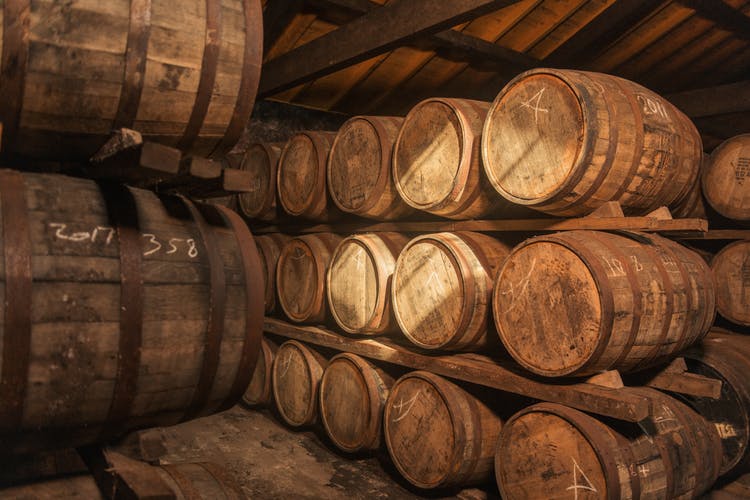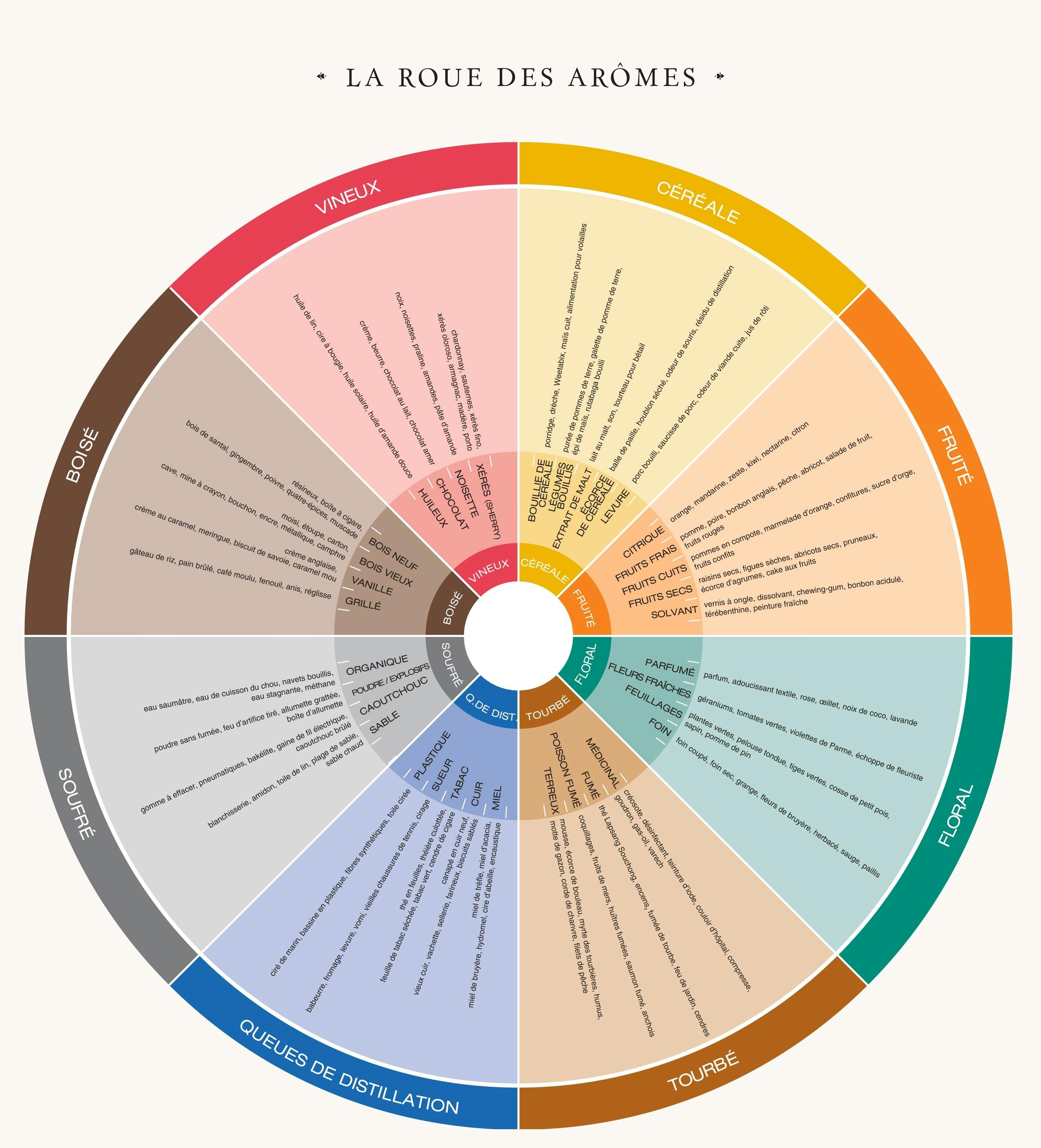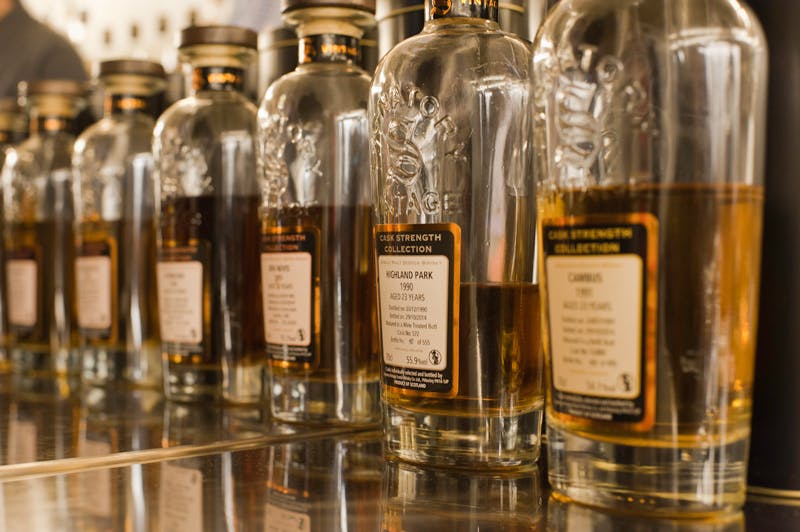
Blending is an art that extends beyond whisky. Other spirits, wines, perfumes, teas, and coffees can also be blended. This practice originated in Scotland in the 19th century, with the rise of wine and spirit merchants: John Walker of Kilmarnock (1820), George Ballantine of Edinburgh (1827), William Teacher of Glasgow (1830), James Chivas of Aberdeen (1839), and John Dewar of Perth (1846). These whisky barons were true visionaries, leaving an indelible mark on the whisky industry and its history, well beyond Scotland’s borders.
The different types of blending
The Beginnings
A representative of Smith's of Glenlivet, Andrew Usher launched the first commercial whisky brand, Usher’s Old Vatted Glenlivet. This whisky was the result of a blending (or vatting) of several casks of different ages from the same distillery (Glenlivet).
This practice had been recognized earlier in a law passed in 1853. A few years later, the Spirit Act of Gladstone allowed the blending of grain whisky and malt whisky in warehouses, thus contributing to the success of blended scotches.
Blending and Scotch Blended
Blended scotches are made by mixing single malts and grain whiskies. The latter were originally made from a blend of malted and unmalted barley, distilled in traditional pot stills. The introduction of the patented still in 1830, which was more economical, marked a significant turning point.
In 1846, the repeal of the Corn Laws (which limited the use of certain grains) allowed distillers to replace the mix of malted/unmalted barley with a more affordable blend of grains, including a high proportion of corn.
These factors, combined with the phylloxera crisis that devastated French vineyards from the 1860s onwards, allowed blended scotches to quickly establish themselves on the international stage.
Blended Malts and Blended Grain Whiskies
Another form of blending involves combining single malts from different distilleries.

These whiskies, known as blended malts (formerly vatted malts or pure malts), are rarer and mainly produced by large blending houses that offer a few versions: Johnnie Walker Green Label 15 years, Famous Grouse Vintage 1987, Ballantine’s Pure Malt 12 years, etc.
However, this whisky style has also caught the attention of a new generation of makers, such as John Glaser, founder of Compass Box, who has developed blended malts and blended grains by blending several grain whiskies from small batches (blends of multiple casks).
Blending and single malts
The blending technique is also used to produce single malts, by combining whiskies of different ages within the same distillery. The age of the youngest whisky used is shown on the label.

This practice helps to smooth out the differences in aromas and flavors that may exist between different casks, and it applies to the majority of single malts available on the market.
Les arômes dans le blending
Master blenders
Today, master blenders are no longer independent merchants inspired by the 19th century, but professionals employed by blending houses.
Their sense of smell is called upon daily, and their job is not only to ensure the consistency of existing blends but also to assess the quality of new distillates produced by the house’s distilleries.
To assist them in this task, they use a new tool, Cask Management, which improves the traceability of casks (age, origin).
A symphony of aromas
A true conductor, the master blender relies on an infinity of aromas to compose their masterpiece. Each composition is created from an "aromatic score" (a recipe) that serves as a guide while allowing room for imagination.

Richard Paterson, master blender of The Dalmore (©Scott Rankin Photography)
The master blender begins by arranging his "instruments," the whiskies, according to their aromatic profile and complementarity. To create a central theme, he uses the most intense fragrances: fruit aromas (citrus), dried fruits, and flowers.

The harmony can be enriched by greener, herbaceous, or spicy notes. Finally, the percussion comes from peat aromas, including smoky and medicinal notes. Despite the strong identity of certain whiskies, the master blender's priority remains to create a harmonious and complex whole.
The intensity of a masterpiece
In addition to selecting an aromatic palette, the master blender determines the intensity with which each whisky contributes to the final harmony.
Contrary to popular belief, the proportion of grain whisky does not affect the quality as much as it affects the intensity of the blend. Ultimately, the choice of ingredients and their precise dosage are the two most important factors.
For example, a blend containing a significant proportion of peated single malts, some delicate single malts, and a small proportion of grain whiskies may not necessarily be complex.
In general, the ratio of malt whiskies to grain whiskies is about 25/75, and the number of distilleries included can range between twenty and fifty. This diversity serves as a safety net in case a distillery closes.
Creating a masterpiece
Once the whiskies are selected and their proportions defined, the blending process can begin.
Some houses prefer to blend their malt whiskies and grain whiskies separately, while others pour them all into the same vat to rest before dilution. At this stage, the alcohol is adjusted to a level slightly higher or equal to the bottling strength by adding demineralized water.
Some houses bottle the blend after just a few days of "marriage." For others, this step is seen as essential to harmonize the aromas. The whisky is then transferred to used casks to avoid any influence from the wood, for a period of three to six months. Two weeks before bottling, the casks are emptied into a large vat, where the whisky undergoes a final dilution to reach the desired alcohol content.

The decisive role of blended scotches in the development of a modern and sustainable whisky industry is undeniable.
Brands like Ballantine’s, Chivas Regal, Dewar’s, and Johnnie Walker have brought scotch whisky its prestige, respectability, and fame. The blending technique also allows for transcending the specific character of each distillery, giving rise to single malts with more expressive aromatic palettes than ever before.
TO EXPLORE WHISKIES FURTHER
La Maison du Whisky has three boutiques in Paris:
In each of these boutiques, you'll find a wide selection of whiskies, rums, sakes, and other fine spirits.
Because a whisky can be described in a thousand words, our experts will be delighted to guide you through the must-try whiskies at La Maison du Whisky.
Follow our tasting calendar for upcoming events, or visit the Golden Promise Whisky Bar, which offers an extensive selection of whiskies and other spirits by the glass.
Written by
- Quentin JEZEQUEL - SEO project manager at LMDW.
Verified by
- Didier GHORBANZADEH - Wine & Spirits Expert at LMDW
- Clotilde NOUAILHAT - Editorial and Corporate Communications Manager at LMDW